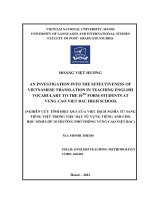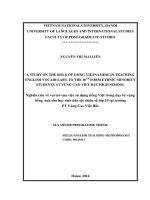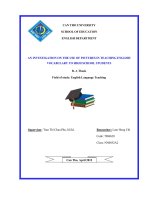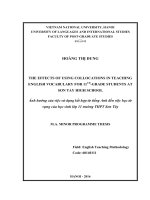THE EFFECTIVENESS OF USING PICTURES IN TEACHING ENGLISH VOCABULARY TO SECONDARY SCHOOL STUDENTS ¬
Bạn đang xem bản rút gọn của tài liệu. Xem và tải ngay bản đầy đủ của tài liệu tại đây (515.22 KB, 106 trang )
MINISTRY OF EDUCATION AND TRAINING
QUY NHON UNIVERSITY
NGUYỄN VÕ MINH THƯ
THE EFFECTIVENESS OF USING PICTURES IN TEACHING
ENGLISH VOCABULARY TO SECONDARY SCHOOL STUDENTS
FIELD OF STUDY: THEORY AND METHODOLOGY
OF ENGLISH LANGUAGE TEACHING
SUPERVISOR : LÊ NHÂN THÀNH, PhD
Quy nhon, 2022
BỘ GIÁO DỤC VÀ ĐÀO TẠO
TRƯỜNG ĐẠI HỌC QUY NHƠN
NGUYỄN VÕ MINH THƯ
HIỆU QUẢ CỦA VIỆC SỬ DỤNG HÌNH ẢNH TRONG DẠY TỪ
VỰNG TIẾNG ANH CHO HỌC SINH TRUNG HỌC CƠ SỞ
CHUYÊN NGÀNH: LÝ LUẬN VÀ PHƯƠNG PHÁP DẠY HỌC
MÔN TIẾNG ANH
NGƯỜI HƯỚNG DẪN KHOA HỌC: TS. LÊ NHÂN THÀNH
Quy nhon, 2022
ii
STATEMENT OF ORIGINAL AUTHORSHIP
The work contained in this thesis has not previously been submitted for
a degree or diploma at any university. I certify that my thesis contains no
material, to the best of my knowledge and belief, except when specifically
stated in the thesis. My thesis contains no previously published or written
content by any other individual.
Signed:
Date:……../………/….......
i
ACKNOWLEDGEMENTS
Without the support, encouragement, and contributions from my Assoc.
Prof. Doctors, Doctors, colleagues, friends, and family, the successful
completion of this thesis work would not have been possible. I take this
chance to appreciate them for their expert advice and wise invaluable
comments, and generous time. They have enriched my knowledge and made
my graduate journey a memorable chapter in my life.
This paper could not have been completed without the encouragement
and contributions of several individuals and groups to whom I would like to
express my deep sense of gratitude during the stressful time of writing this
paper.
First of all, I am grateful to my thesis supervisor, Dr. Le Nhan Thanh,
for his support, patience, and encouragement throughout my study. His
technical and editorial advice was essential to the completion of this paper
and has offered me several lessons and insights on how academic research
works in general. I was fortunate to have a supervisor that genuinely cared
about my job. It is not my success without his valuable comments,
suggestions, and corrections.
Besides, I also take this opportunity to express gratitude to all the
lectures who took part in the training process of the MA course at Quy Nhon
University for their scholarly knowledge and experience as well as their
inspirational to me which incited me to widen my research from various
perspectives.
This study was made achievable by the presence of the enthusiastic
students at Tran Phu Secondary School, who devoted their time to taking part
ii
in this research. I was also thankful to my colleagues for their fascinating
assistance, support, and management during the pilot phase.
Last, but not least, I am grateful for all the support and encouragement I
received from my beloved parents and my brother throughout my thesis
education.
Your contribution is important. Thank you all for your help and
support.
iii
ABSTRACT
Vocabulary plays an important role in learning a foreign language. It
supports students in learning other skills such as reading, writing, listening,
and speaking. Language teachers have already employed mind mapping
techniques to encourage their students to learn vocabulary. The current study
aimed at investigating the effectiveness of using pictures to teach grade-7
students to learn English vocabulary. The sample of the study consisted of 40
grade-7 students at a secondary school in Ninh Thuan province. Those
students were equally divided into two groups (experimental and control).
The research was conducted based on mixed methods since it employed an
experiment and a survey. These participants were divided into 2 groups: the
control group and the experimental group. Data were collected from three
sources: (1) the pre-test and post-test to estimate the students’ vocabulary
improvement, (2) the questionnaire to assess how the changes in their
opinions towards vocabulary learning with pictures were, and (3) observation
classroom was carried out to gather data related to students' reactions and
responses in vocabulary lessons. The findings of the study reveal that pictures
greatly affect EFL secondary school students’ learning of vocabulary.
Secondly, an experiment was carried out to examine the impact of pictures on
grade-7 students’ mastery of English vocabulary. The results of the
experiment showed that there are statistically significant differences in the
mean scores of the experimental and control groups in the vocabulary posttest
due to the use of pictures in favor of the experimental group. Along with the
experiment. Based on the findings, the research provided suggestions that
help students and teachers use pictures in learning and teaching vocabulary
successfully.
iv
Keywords: effectiveness, pictures, school students, students’
responses, teaching English vocabulary
v
CONTENTS
STATEMENT OF ORIGINAL AUTHORSHIP...............................................i
ACKNOWLEDGEMENTS................................................................................ii
ABSTRACT.........................................................................................................iv
CONTENTS.........................................................................................................vi
LIST OF TABLES..............................................................................................ix
LIST OF FIGURES.............................................................................................x
LIST OF ABBREVIATIONS............................................................................xi
CHAPTER 1. INTRODUCTION.......................................................................1
1.1 Rationale..................................................................................................1
1.2 Aim of the Study.....................................................................................2
1.3 Objectives of the Study...........................................................................3
1.4 Research Questions.................................................................................3
1.5 Scope of the Study...................................................................................3
1.6 Significance of the Study........................................................................3
1.7 Organization of the Thesis......................................................................3
CHAPTER 2. LITERATURE REVIEW...........................................................5
2.1 Vocabulary..............................................................................................5
2.1.1 Definitions.............................................................................................5
2.1.2 Classification of vocabulary..................................................................6
2.1.3 Important role of vocabulary in teaching and learning English............7
2.1.4 How to make vocabulary teaching and learning effective....................8
2.1.5 Stages in vocabulary teaching...............................................................9
2.1.6 Techniques in teaching English vocabulary........................................12
2.1.7 Factors affecting vocabulary retention................................................13
vi
2.2 Pictures..................................................................................................19
2.2.1 Definition.............................................................................................19
2.2.2 Principles of selecting a picture...........................................................20
2.2.3 Types of pictures.................................................................................20
2.2.4 The use of pictures...............................................................................26
2.2.5 The advantages and disadvantages of using pictures..........................27
2.2.6 Using pictures in vocabulary teaching activities.................................29
2.3 Testing...................................................................................................32
2.3.1 The important role of testing...............................................................32
2.3.2 Vocabulary tests..................................................................................33
2.4 Related studies on using pictures to teach vocabulary..........................34
CHAPTER 3. RESEARCH METHODOLOGY.............................................37
3.1 Research Design....................................................................................37
3.2 Participants............................................................................................37
3.3 The Textbook........................................................................................38
3.4 Data Collection Instruments..................................................................40
3.4.1 Questionnaires for students.................................................................40
3.4.2 Vocabulary tests..................................................................................41
3.4.3 Classroom observations.......................................................................42
3.5 Data Collection......................................................................................43
3.5.1 Administering the questionnaires........................................................43
3.5.2 Administering the vocabulary tests.....................................................43
3.5.3 Administering the classroom observations..........................................44
3.6 Data Analysis........................................................................................45
3.6.1 Quantitative analysis of the questionnaires.........................................45
vii
3.6.2 Quantitative analysis of the pre-test and post-test...............................45
3.6.3 Qualitative analysis of the classroom observations.............................46
3.7 Validity and Reliability.........................................................................46
3.8 Summary...............................................................................................49
CHAPTER 4. RESULTS OF THE STUDY....................................................50
4.1 Students’ Responses to Learning New Words Through Pictures.........50
4.1.1 Advantages of learning vocabulary with pictures...............................50
4.1.2 Disadvantages of learning vocabulary with pictures...........................52
4.1.3 Students’ intentions of future learning vocabulary with pictures.
..........................................................................................................................54
4.2 The Effectiveness of Teaching New Words by Using Pictures............55
4.2.1 Findings from the two tests.................................................................55
4.2.2 The effectiveness of teaching new words using pictures as
explored from the classroom observations.......................................................59
4.3 Summary...............................................................................................67
4.4 Chapter Summary..................................................................................68
CHAPTER 5. DISCUSSION AND CONCLUSION.......................................69
5.1 Summary of Key Finding of the Study.................................................69
5.2 Pedagogical Implications......................................................................70
5.3 Limitations............................................................................................71
5.4 Suggestions for Further Research.........................................................72
REFERENCES...................................................................................................73
APPENDICES....................................................................................................77
viii
LIST OF TABLES
Table 3.1 Background Information of the Participants........................38
Table 3.2 Reliability Statistics for the Questionnaire...........................47
Table 3.3 Descriptive Statistic for the Pre-tests and the Post-tests......48
Table 4.1 Advantages Brought About by Learning Vocabulary with
Pictures............................................................................................................50
Table 4.2 Disadvantages Findings From Learning Vocabulary with
Pictures............................................................................................................52
Table 4.3 Students’ Intentions of Future Learning Vocabulary with
Pictures............................................................................................................54
Table 4.4 Mean Difference in Students’ Vocabulary Mastery Within the
Control Group.................................................................................................56
Table 4.5 Mean Difference in Students’ Vocabulary Mastery Within the
Experimental Group........................................................................................56
Table 4.6 Students’ Scores on Vocabulary Tests Between the Two
Groups.............................................................................................................57
Table 4.7 The Number of Students Who Remember 3 and 4 Words.....61
ix
LIST OF FIGURES
Figure 4.1. Summary of participant’s vocabulary mastery before and
after the study..................................................................................................58
Figure 4.2. The students’ participation in class....................................63
Figure 4.3. Students in slap the board game.........................................65
Figure 4.4. Classroom interaction........................................................66
x
LIST OF ABBREVIATIONS
EFL: English as Foreign Language
SPSS: Statistical Package for the Social Sciences
xi
CHAPTER 1. INTRODUCTION
To set the scene for the study, chapter 1 describes the rationale for the
study, the research aim and objectives, and the research questions. This is
followed by the scope and the significance of the study. Finally, there is an
overview of the organization of the study.
1.1 Rationale
Vocabulary plays an important role in learning a foreign language. The
extent of students’ vocabulary knowledge relates strongly to reading
comprehension and overall academic success Doff (1988). If students do not
have a good vocabulary, they will find it difficult to read a passage, listen to a
conversation, write a paragraph, and communicate in English. As a result, they
gradually lose interest in learning a language. Besides, most students in high
school often have problems with learning new words. They learn English
vocabulary in an uninteresting and passive way. Teachers make a list of new
words and give Vietnamese definitions, and they try to learn them by heart. As a
result, students tend to copy definitions, repeat them back to their teacher and
shortly forget the words altogether (Greenwood, 2002). Therefore, the teacher
must apply other vocabulary teaching techniques to help students learn new
words more effectively. There are many kinds of methods and techniques to
teach vocabulary to students such as teaching vocabulary by using pictures,
examples, definitions, and synonyms (Nation, 1990). Among them, using
pictures is one of the techniques that play a significant role in helping learners
remember new words better (Nattinger, 1998). According to Nattinger (1998),
words in our mental lexicon are connected not only by meaning, form, and
sound but also by sight. It means that pictures are useful aids in fixing words in
students’ memory. Moreover, Gerlach (1980) also states that pictures could
attract students’ attention In short, pictures are appropriate for presenting and
1
checking the meaning of new words. From the statement, it can be seen that
vocabulary functions as a cornerstone, without which any language could not
exist. Speaking would be meaningless and perhaps impossible with only
structures and without vocabulary. Therefore, the English teacher has to be able
to organize teaching and learning activities; they have to give materials by using
a suitable technique and master the lesson effectively. Especially in learning
vocabulary, teachers must make students able to memorize such words in the
English language and groups of new words. Maria (1987) stated that research in
first and second language acquisition suggests that initial teaching priorities for
language areas should be vocabulary, pronunciation, and grammar. Therefore,
the English teacher has to be able to organize teaching and learning activities,
and they have to give materials by using a suitable technique and master the
lesson effectively.
Especially in learning vocabulary, teachers must make students able to
memorize such words in the English language and group new words. The
statements above mean that vocabulary is important to teach and teachers must
try to find the most effective way to help learners retain new words in long-term
memory.
Available literature has indicated the benefits of pictures (Joklova, 2009;
Leny, 2006; Shinta, 2006). Yet, there have been few studies in a secondary
school context. Therefore, this study aims to explore the effectiveness of using
pictures to teach English vocabulary to students at a secondary school in Ninh
Thuan province in a two-month experimental study. It is envisaged that the
outcome would add to the field of EFL teaching and learning in terms of
vocabulary teaching strategies for students.
2
1.2 Aim of the Study
This research aims to explore the effectiveness of using pictures in
teaching English vocabulary to students at a secondary school.
1.3 Objectives of the Study
To achieve this aim, the researcher tried to fulfill the following objectives:
1. To examine students’ responses to learning new words through pictures
2. To evaluate the effectiveness of teaching new words using pictures.
1.4 Research Questions
1. What are students’ responses to learning new words through pictures?
2. How effective is teaching English vocabulary to students through
pictures?
1.5 Scope of the Study
The research was carried out with the participation of all 40 students who
were learning at a secondary school in Ninh Thuan Province. This study just
focused on using pictures in teaching English vocabulary. The data was
collected through questionnaires, vocabulary tests, and classroom observations.
1.6 Significance of the Study
While much research has been conducted on the use of pictures, there
are few studies to be done in Vietnam, especially in EFL secondary school
context, it is significant to carry out the study because the findings of the
study will provide be beneficial for teachers as they may use pictures more
often in their vocabulary teaching. Besides, students will be taught how to learn
vocabulary more effectively by using pictures. Thus, it is hoped that the findings
of this study would be pedagogically significant for teaching and learning
vocabulary.
3
1.7 Organization of the Thesis
The thesis consists of five chapters:
Chapter 1, Introduction, presents the rationale for conducting the study,
the research aims and questions, the objectives of the study, the research
significance, and the structure of the thesis.
Chapter 2, Literature Review, provides a theoretical framework for the
study including definitions of vocabulary, classification of the vocabulary, the
roles of vocabulary in teaching and learning English, problems of learning
English vocabulary, and effective ways to learn vocabulary. Besides, the
meaning of pictures, types of pictures, the use of pictures, and their advantages
and disadvantages will be discussed, as related studies on the use of pictures.
Chapter 3, Research Methodology, describes the methodology used in
the research involving research design, participants, instruments, and the
procedures for data collection and analysis.
Chapter 4, Findings and Discussion, presents the results gained in the
processing of the data and discusses the results of the data analysis.
Chapter 5, Conclusion, summarizes the findings, presents the limitations
of the study of teaching vocabulary using pictures, provides some suggestions
for further study, and gives implications on teaching vocabulary.
4
CHAPTER 2. LITERATURE REVIEW
Chapter 2 to shape the theoretical framework of the study. The first one
presents vocabulary including definitions, the important role of vocabulary in
teaching and learning English, how to make vocabulary learning and teaching
effective, and techniques for teaching vocabulary. The second part describes
pictures with definitions, types of pictures, the use of pictures, and the
advantages and disadvantages of pictures used. The next section discusses
testing consisting its important role and vocabulary tests. Besides, some related
studies on the use of pictures are also mentioned. A summary of the theoretical
background is also provided at the end of this chapter.
2.1 Vocabulary
There are different definitions of vocabulary as it is an important factor in
learning a foreign language. Each linguist gives his definition of vocabulary
depending on the criteria that he considers the most important in terms of
linguistics, semantics, lexicology, etc.
2.1.1 Definitions.
According to Hatch and Brown (1995), vocabulary is the list of words that
speakers of particular language use. Meanwhile, Carter (1998, p.25) defines
vocabulary as the smallest meaningful component of language. Likewise,
Bloomfield (1993) and Carthy (1992, p. 32) also agree that a word is a separate
item of language. Furthermore, vocabulary is “a core component of the language
proficiency and provides much of the basis for how well learners speak, listen,
and write” (Richards & Renandya, 2002, p.255).
From the above-mentioned definitions, it can be seen that vocabulary is
the group of words that speakers use to communicate and express their thoughts
and feelings.
5
2.1.2 Classification of vocabulary.
There are different ways of vocabulary classification according to
different criteria, features, or functions.
In terms of semantics, Schmitt (2008) states that vocabulary can be
divided into notional words and functional words. Notional words are those that
have lexical meaning and form a great number of the speaker’s vocabulary.
They are objects, actions, qualities, etc. Functional words are those whose
meanings are grammatical. They only have meanings for other words with
which they are used.
In terms of grammar, vocabulary is classified based on different parts of
speech such as nouns, verbs, adjectives, adverbs, prepositions, etc.
In terms of methodologists, a foreign language learner’s vocabulary is
categorized into two kinds, namely active vocabulary and passive vocabulary.
Active vocabulary refers to the words which the learners can understand and
pronounce correctly and use constructively in speaking or writing. On the other
hand, passive vocabulary refers to the words which the learners can recognize
and understand while they are reading or listening to someone speaking, but
they do not use the words in speaking or writing.
However, some methodologists of the Communicative Language
Teaching approach classify the learner’s vocabulary into productive and
receptive vocabulary. The productive vocabulary is the words that the learners
can use effectively to produce information in speaking and writing. The
receptive vocabulary is the words for the learner to receive and understand the
information in listening and reading. As foreign language teachers, the teachers
should know these classifications so that they can help students learn vocabulary
6
better, especially helping students widen their vocabulary with more active and
productive words.
2.1.3 Important role of vocabulary in teaching and learning English.
Learning a language, especially English means learning the components
of a language. Vocabulary is one of the components of language. So, the
mastery of vocabulary is important because it supports the speakers in
communication. Furthermore, vocabulary is also much more important than
grammar because something could be expressed with the help of grammar. It is
also key for students to understand what they hear and read in school and to
communicate successfully with other people. Similarly, Saville and Troike
(1984) also acknowledge that vocabulary knowledge is the single most
important. It is one of the components that supports other skills such as
listening, speaking, reading, and writing. Students cannot effectively express
their ideas and meanings if they lack vocabulary. Wilkins (1972, p.110)
emphasized that “vocabulary is one of the three dimensions of languages
(phonetics, grammar, vocabulary). Without grammar, very little can be
conveyed, without vocabulary nothing can be conveyed.” It does not mean that
the author wants to compare vocabulary’s role and grammar but to show a fact
that the author has experienced in her English learning process that language
learners need vocabulary first to communicate. And Harmer (1993, p.153) states
that “if language structures make up the skeleton of language then it is
vocabulary that provides the vital organs and the flesh.” Moreover, Morra and
Camba (2009, p.85) also emphasizes that “nowadays it’s widely accepted that
vocabulary learning is one of the essential elements both of acquisition of one’s
native language and of learning a foreign language.” Currently, when the
Ministry of Education (2019) decides to teach English to primary school
students instead of starting in middle school, parents are very interested in
7









